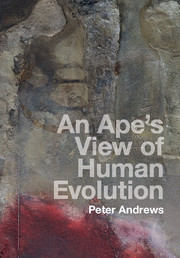Book contents
- Frontmatter
- Contents
- Preface
- 1 How can we recognize common ancestors?
- Part I Apes: their morphology and behaviour
- PART II Environments and palaeoenvironments
- Part III Review of fossil apes
- Part IV Last common ancestor
- 16 Putting together the evidence
- 17 An ape's view of human evolution
- References and further reading
- Index
- References
17 - An ape's view of human evolution
from Part IV - Last common ancestor
Published online by Cambridge University Press: 05 January 2016
- Frontmatter
- Contents
- Preface
- 1 How can we recognize common ancestors?
- Part I Apes: their morphology and behaviour
- PART II Environments and palaeoenvironments
- Part III Review of fossil apes
- Part IV Last common ancestor
- 16 Putting together the evidence
- 17 An ape's view of human evolution
- References and further reading
- Index
- References
Summary
In this last chapter, I am going to consider the evidence for when the last common ancestor might have lived, what kind of environment it lived in and what its major characteristics were.
The date of the last common ancestor
There is no direct evidence on the date of the common ancestor. I have shown in Chapter 3 how the ‘molecular clock’ has to be calibrated from the fossil record, and the two most reliable calibration points are the divergence of monkeys and apes and the divergence of the orang utan. Nothing is known about gibbon ancestry or the divergence date of gibbons from other apes, and the evidence for the timing of gorilla divergence is no better than that for humans and chimpanzees. The earliest fossil records for both monkeys and apes are in the early Miocene of East Africa, and both occur about 20 million years ago, for I am not convinced by the apparent monkey and ape species recorded from the Oligocene of Tanzania (see discussion in Chapter 3). How much earlier the actual split occurred is of course not known, and based on the high diversity of fossil ape species by 18 million years, it might be up to 6 million years earlier.
The second divergence date often used for calibrating the ‘molecular clock’ is that for the orang utan. In Chapter 3, I have discussed some of the difficulties in setting a date for this event. It was proposed that the Indian ape Sivapithecus indicus was on the orang utan lineage, and since the earliest record for this fossil ape is about 12 million years, this gives a minimum age for the origin of the orang utan lineage. However, the postcranial skeleton of this fossil ape is nothing like that of the orang utan, whereas the skeleton and some aspects of the skull of Hispanopithecus laietanus from 9 million-year-old deposits in Spain, and the lower jaw of Khoratpithecus from Thailand slightly later in time, have stronger similarities with the orang utan. The earliest dryopithecines known in Europe also date from about 12 million years, and it seems possible that there were at least two evolving lineages within this group, one ancestral to Ponginae and the other ancestral to African apes, as suggested by David Begun.
- Type
- Chapter
- Information
- An Ape's View of Human Evolution , pp. 253 - 259Publisher: Cambridge University PressPrint publication year: 2016



